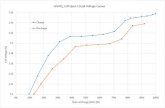I’m a little late to the party here, but I have to ask: how often should a full charge be accomplished to wipe memory effects before they become permanent? Once a month? 6 months? a week? I’ve got 3 55A Midnite Classic 250s charging my 50kwh LFP bank w/ a Radian GS8048 inverter. I can adjust the bulk and adsorption voltages & time, and turn off the float.
Nothing I have allows me monitor current and get that information into the Midnites or Radian in a useful way.
The only way I can see accomplish a periodic full charge is to set the equalize function to 3.6v/cell and the time to a value I establish w/ a current monitor to when the charge current gets to 0 or near 0 and then have it repeat once a week/month/etc.
If you have any ideas I’d love to hear them.
Thanks
Eric Bretscher says:
30 December 2019 at 7:46 am
Memory effects don’t become permanent, they just become more difficult to overcome. Your question is difficult to answer because there is not much data available and it depends too much on the operating regime of the bank. Performing a full recharge once or twice a year would appear to be quite enough in most cases.
If you can’t monitor current and use this information, you can’t achieve a correct charge termination. The absorption time varies a lot with the condition (and age) of the cells, so trying to deterine a fixed absorption time is a flawed strategy. You must use voltage and current.
Trying to charge LFP banks with lead-acid chargers doesn’t work properly. The BMS must measure the current and be able to control the charge termination.
Best regards,
Eric



